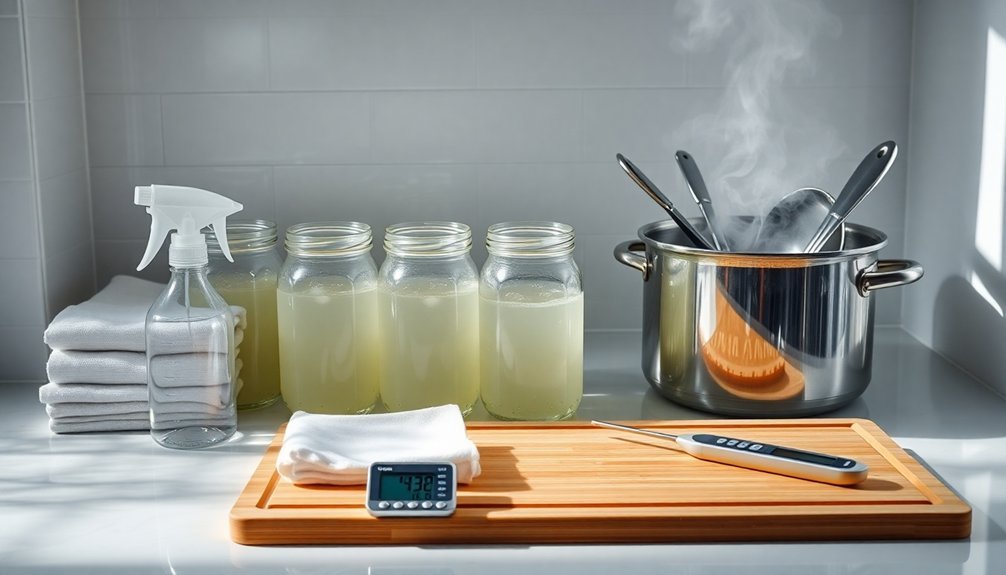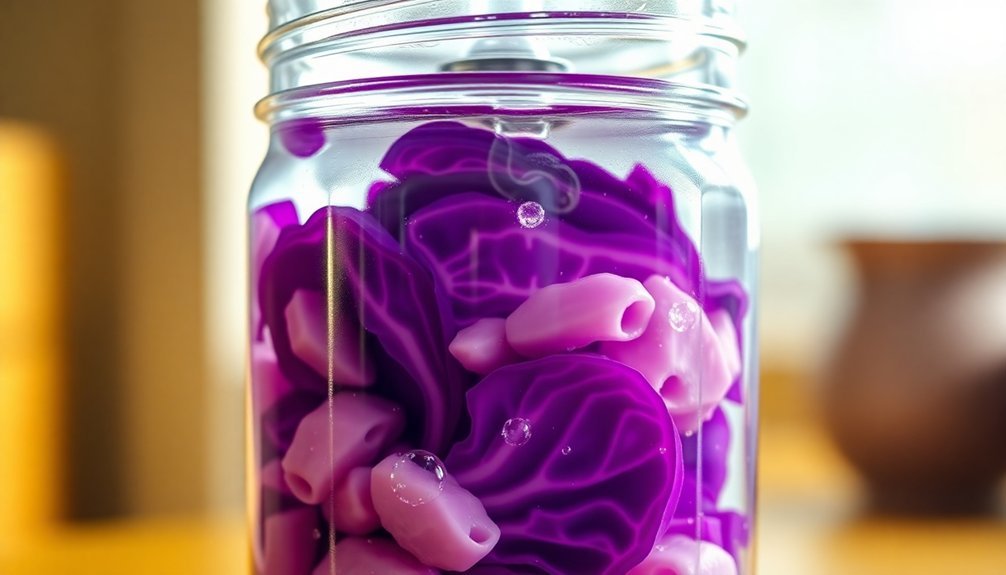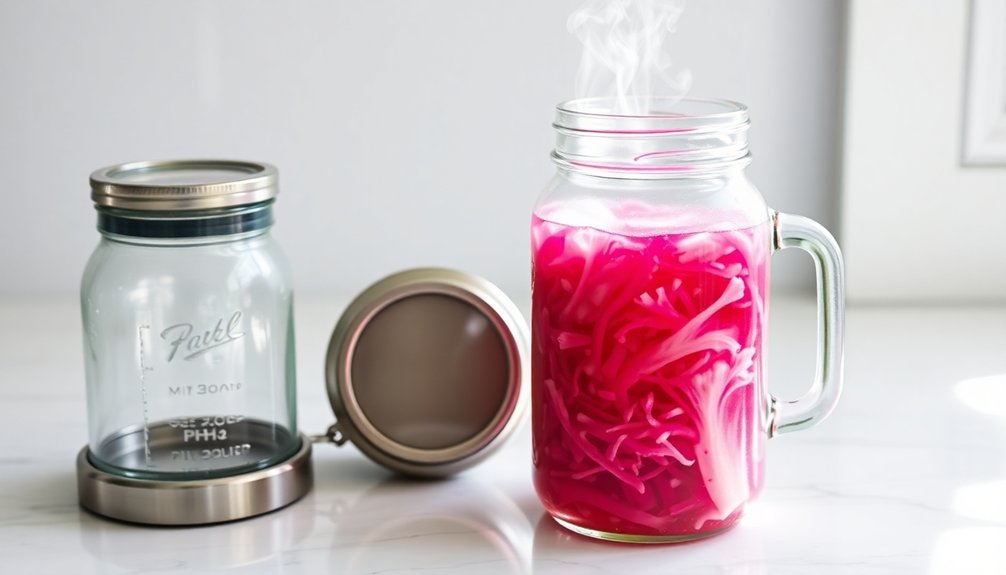To guarantee safe fermentation at home, you'll need to follow three critical practices. First, thoroughly sanitize all your equipment with warm soapy water and a food-grade sanitizer to prevent unwanted bacteria growth. Second, maintain precise temperature control and proper salt levels (2-5% by weight) to create an environment where beneficial bacteria thrive while harmful ones can't survive. Third, always keep your ingredients fully submerged beneath the brine using weights or specialized lids, as this creates the oxygen-free environment essential for successful fermentation. Understanding these fundamentals will set you up for consistent, contamination-free results in your fermentation projects.
Sanitize Everything First

When starting any fermentation project, thorough sanitization stands as your first and most vital line of defense against contamination. You'll need to properly clean and sanitize all equipment to prevent unwanted bacteria, yeast, or mold from spoiling your ferments.
Begin by cleaning your equipment with warm, soapy water. Use a soft-bristled brush to scrub vessels thoroughly, paying special attention to removing any food residue or oils. Dirty vessels cannot be effectively sanitized, so take extra care during the cleaning phase. Rinse everything with hot water until you've removed all detergent.
Next, apply a food-grade sanitizer like Star San or Iodophor. You can also use boiling water for jars and smaller equipment. Let your sanitizing solution work for at least 10 minutes on all surfaces. For items like kegs, bottles, and containers, extend the soaking time to 30 minutes or more.
Don't forget to sanitize your transfer tubes, immersion chillers, and oxygen diffuser stones. After sanitizing, rinse thoroughly with hot water and either air dry or use a clean towel.
This vital step becomes even more important for long-term ferments lasting several weeks or more. If you skip proper sanitization, you risk ruining entire batches and creating off-flavors in your final product.
Monitor Temperature and Salt Levels
Two critical factors in successful fermentation are maintaining proper temperature and salt levels throughout the process. Your fermentation's success depends on creating the perfect environment for beneficial bacteria while preventing harmful microorganisms from taking hold. Advanced temperature controllers can maintain temperatures within half a degree of your target.
To monitor temperature effectively, you'll need reliable measuring tools. A stopper thermowell provides the most accurate readings by placing the probe directly in the fermentation. If you're using an external probe, remember readings may vary by up to five degrees. For precise control, consider using a water bath incubator or temperature controller with probes.
Salt concentration plays an essential role in managing osmotic pressure and creating an ideal environment for lactic acid production. For most vegetable fermentations, you'll want to maintain a 2-5% salt concentration by weight.
- Use multiple thermometers to verify your temperature readings
- Keep fermentation temperature consistent to prevent unwanted bacterial growth
- Measure salt carefully – too little allows harmful bacteria, too much inhibits beneficial ones
- Monitor the fermentation vessel wall temperature with LCD adhesive strips
- Adjust salt levels based on your specific recipe (2-3% for sauerkraut, different for other foods)
Keep Ingredients Submerged

Beyond temperature and salt levels, keeping your ingredients fully submerged stands as a fundamental rule of safe fermentation. When you properly submerge your ingredients, you're creating an anaerobic environment that prevents oxygen exposure and promotes the growth of beneficial lactic acid bacteria (LAB). The ideal duration for most vegetable ferments is 5 days to 2 weeks.
| Aspect | Benefit |
|---|---|
| Oxygen Prevention | Creates ideal conditions for LAB growth while preventing harmful microbes |
| Mold Protection | Eliminates surface mold risk and reduces contamination chances |
| Brine Contact | Guarantees uniform salt distribution and consistent fermentation |
| Equipment Needs | Requires weights, airlocks, or vacuum sealing for proper submergence |
You'll need to use appropriate weights or fermentation tools to keep ingredients below the brine level. Consider using glass fermentation weights, vacuum packing, or specialized fermentation lids with built-in airlocks. These tools help maintain a clean, controlled environment while allowing carbon dioxide to escape during fermentation.
Don't underestimate the importance of consistent submergence – it's your primary defense against spoilage and contamination. If you're using a traditional fermentation vessel, check regularly to verify ingredients haven't floated to the surface, and adjust weights as needed to maintain proper submergence throughout the entire process.
Frequently Asked Questions
How Do I Know When My Fermented Food Has Gone Bad?
You'll know your ferment's spoiled if you spot mold (green, blue, black), detect putrid smells, notice slimy textures, or see excessive yeast growth. Don't eat anything that smells rotten or looks abnormal.
Can I Mix Different Vegetables in the Same Fermentation Container?
Yes, you can mix different vegetables together! Just make certain they're compatible in texture and flavor. Remember that red vegetables like beetroot and cabbage will color other vegetables and the brine during fermentation.
Which Fermented Foods Are Safe for Pregnant Women to Consume?
You can safely consume store-bought sauerkraut, pasteurized kefir, pasteurized kimchi, plain yogurt with live cultures, and miso during pregnancy. Avoid homemade ferments, kombucha, and unpasteurized products for your safety.
Should I Remove the White Film Forming on Top of My Ferment?
If it's Kahm yeast (wrinkled, white film), you can safely skim it off and continue fermenting. However, if you notice fuzzy patches or unusual odors indicating mold, you'll need to discard the batch.
How Long Can I Store Homemade Fermented Foods After They're Ready?
You can store your fermented foods in the fridge for up to a year, but storage time varies by type. Fermented fruits last weeks, kimchi up to a year, and drinks should be consumed within 6 months.
In Summary
You'll find fermentation success by following these three fundamental safety practices. When you properly sanitize your equipment, maintain ideal temperatures and salt ratios, and keep vegetables below the brine, you're creating the perfect environment for beneficial bacteria while preventing harmful growth. With these essentials mastered, you're well on your way to enjoying safe, delicious fermented foods right from your kitchen.





Leave a Reply